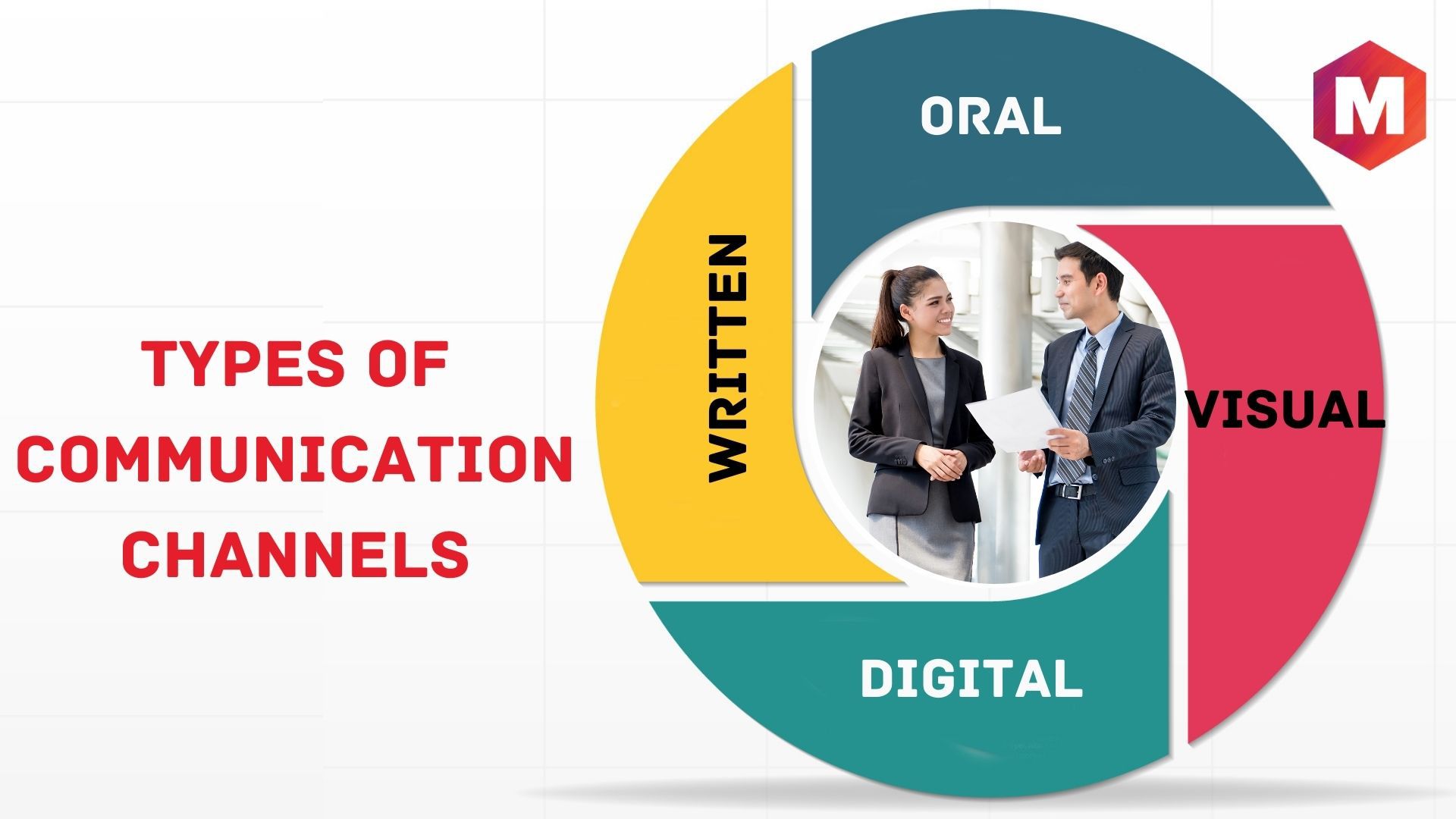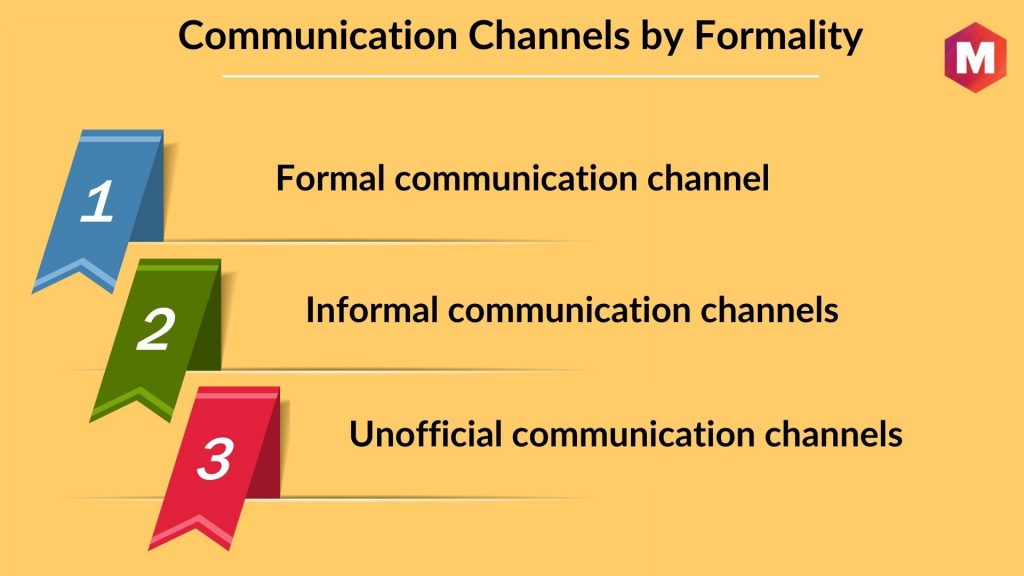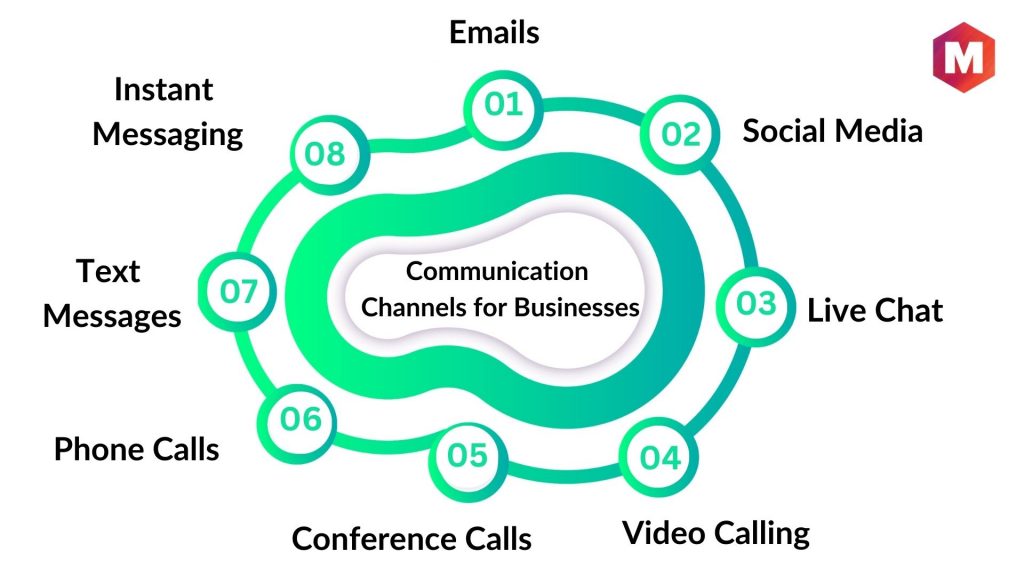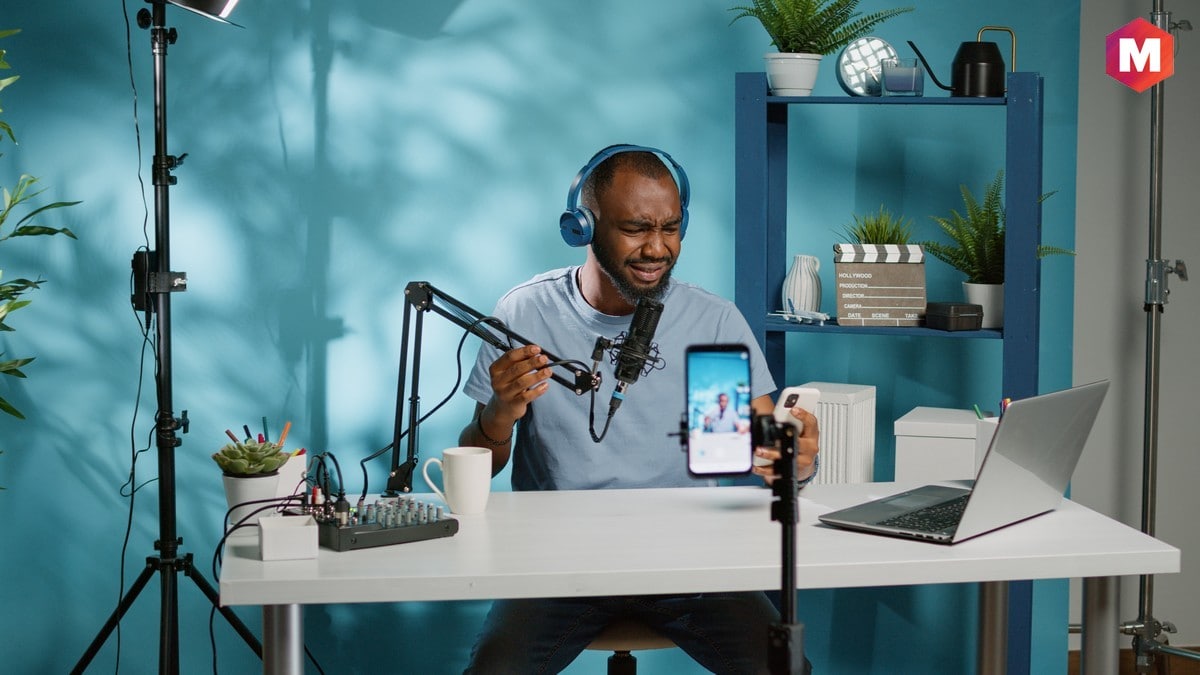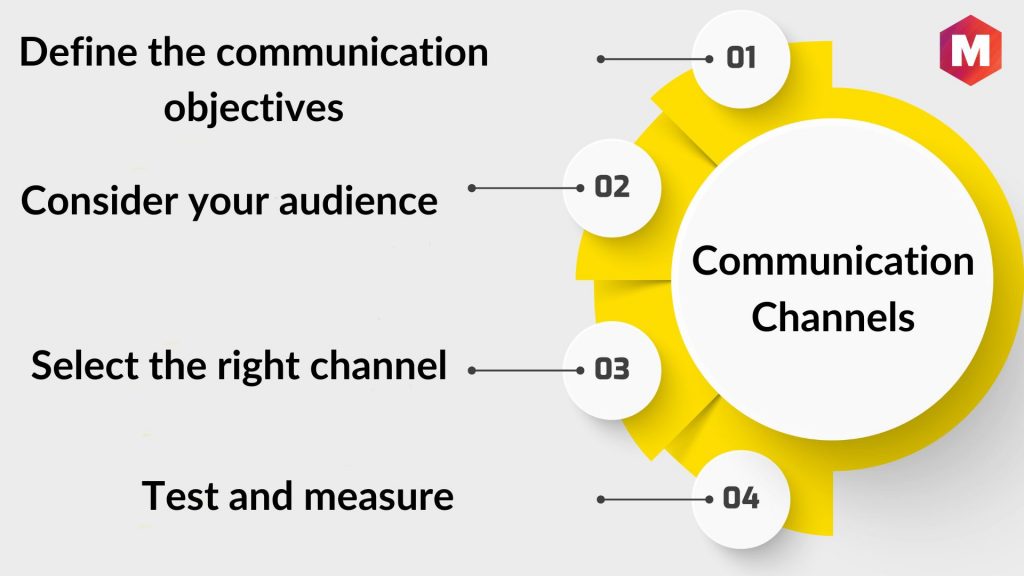Communication channels are the methods that are used to communicate, such as phone calls, text messages, emails, and face-to-face conversations. Communication channels can be categorized by their purpose, such as to inform, request, give feedback, or build relationships.
The most common communication channels are verbal communication, such as face-to-face conversation, telephone calls, and video conferencing. Nonverbal communication channels include body language, such as facial expressions and gestures, as well as written communication, such as email, text messages, and social media posts. Finding the most important communication channel for delivering a message is the most crucial thing in ensuring the success of business communications.
Table of Contents
What are Communication Channels?
Definition: Communication channels are defined as the ways that people in an organization, workplace, or regular life interact with one another and communicate. It’s almost impossible to align workers with company objectives, break down silos, and promote creativity in the workplace without the appropriate communication channels in place.
The choice of communication channel is crucial for any business meeting. Whether you’re revealing new information to the entire company or discussing a project with a single colleague, knowing which sort of communication channel is ideal will influence the outcome significantly.
Types of Communication Channels
Successful business messages are delivered through a wide variety of communication channels.
From the body language to the written verbal communications channel to other communication channels, all play quite a crucial role in channelizing communications.
Let us have a look at some of the types of communication here and now
1. Written
Written communication channels are the most formal of all forms of communication, yet they are also the slowest.
Written correspondence is commonly used for contracts, notifications, and other company-wide papers that need a more formal tone or signature. Various forms of written communication through internal channels are possible, including:
- Memos
- Letters
- Reports
2. Oral
Oral communication channels are the quickest but least formal form of communication. This type of verbal communication is often used for brainstorming sessions, small talk, and impromptu meetings.
Because oral communication can be hard to document, it’s often used in conjunction with another form of communication, such as email or instant messaging. Various forms of oral communication are possible, including:
- Telephone calls
- Video conferencing
- In-person meetings
3. Visual
Visual communication channels are a mix of both formal and informal channels.
Visuals can be used to convey information quickly and effectively, making them ideal for presentations, infographics, and other types of business communications. Various forms of visual communication are possible, including:
- PowerPoint presentations
- Videos
- Infographics
- Images
4. Digital
Digital channels are the quickest and most informal of all types of communication channels. Digital channels are often used for small talk, brainstorming sessions, and impromptu meetings.
Because digital communication can be hard to document, it’s often used in conjunction with another form of communication, such as email or instant messaging. Various forms of digital communication are possible, including:
- Instant messaging
- Chat rooms
- Social media
- Webinars
Did you know that choosing the right communication channel can significantly impact business success?
The importance of digital communication channels in today’s business landscape cannot be overstated. According to a 2023 survey by Statista, 78% of businesses report using digital communication tools more frequently now than before the pandemic. This shift signifies a critical change in how companies interact internally and externally. The widespread integration of platforms like Microsoft Teams and Zoom highlights the need for companies to adopt digital solutions to stay competitive and maintain seamless communication (Statista, 2023).
Quick Tip: To improve internal communication, businesses can leverage project management tools such as Asana or Trello. By organizing tasks and assigning responsibilities, these tools streamline workflow and keep team members informed. According to a study by the Project Management Institute, organizations using digital project management tools report a 25% increase in project success rates. By implementing these tools, your team can maintain clarity, stay on track, and achieve goals more efficiently (Project Management Institute, 2022).
Communication Channels by Formality
Different communication channels on the grounds of formality are
1. Formal communication channel
Company business plans, strategy, goals, annual reports, agreements, company-wide communications, workplace safety policies and procedures, and board presentations are just a few examples of formal communication.
Channels used for this are board meetings, Town halls, video conferences, and webinars. Such effective communication channels are crucial for successful external communication as well as internal communication in an organization
2. Informal communication channels
Communication about day-to-day tasks, project updates, employee feedback, new ideas, and feedback are a few examples of informal communication.
This is mostly done via email, instant messaging, social media platforms like Yammer, and in person. These are also used for both external business messages and internal communications.
3. Unofficial communication channels
Communication that doesn’t need to be brought to the attention of everyone in the organization and is mostly gossip, such as water cooler conversations, or personal communication is unofficial.
Communication channels for this include office lunches, coffee breaks, and after-work drinks.
Communication Channels by Means or Mediums
1. Digital Communication Channels
Communication that happens via computers and the internet are digital channels.
Communication platforms like Skype, Zoom, Google Hangouts, and GoToMeeting are all examples of digital channels.
2. Analog Communication Channels
Communication that happens without the use of computers or the internet is analog.
Telephone calls, face-to-face conversation, and radio are all examples of analog communication channels.
3. Print Communication Channels
Communication that happens via print media, such as newspapers, magazines, and books, is print communication.
Communication channels for this type include special delivery mail, handouts, and billboards.
4. Broadcast Communication Channels
Communication that happens via television or radio is broadcast communication.
Communication channels for this type include news stations, talk radio, and podcasts.
Communication Channels for Businesses
Let us delve into the world of some of the best business communication channels and their roles for connected teams
1. Emails
Communication via email is the most formal way to reach out to someone. It is perfect when you need to send an official document or a piece of information that needs to be recorded.
2. Social Media
Social media is one of the most commonly used platforms for informal communication. From sharing pictures to having group chats, there is a lot that can be done on social media.
3. Live Chat
Communication via live chat is getting increasingly popular as it allows businesses to communicate effectively with their customers in real-time. This channel is perfect for addressing customer queries and providing support.
4. Video Calling (Face to Face)
Communication via video calls is perfect for those who want a more personal touch than what emails and text messages can provide. This direct channel call is also great for team meetings and training sessions.
5. Conference Calls
Communication via conference calls is perfect for businesses that have employees working in different locations. This channel allows multiple people to join in on a one video call together, making it easier to coordinate and collaborate.
6. Phone Calls
Communication via phone calls is one of the oldest and most reliable methods of communication. This channel is perfect for those who want to have a conversation without being interrupted by other tasks.
7. Text Messages
Communication via text messages is perfect for those who need to communicate quickly and easily. This channel is also great for sending reminders and updates.
8. Instant Messaging
Communication via instant messaging is perfect for those who want to have a conversation in real-time. This channel is also great for brainstorming sessions and impromptu meetings.
Rise of Digital Communication Channels in the Workplace
Digital channels are becoming increasingly popular in the workplace as they offer a number of advantages over traditional methods of using information rich communication channels.
Digital channels are typically quicker and more convenient than traditional methods, such as phone calls and face-to-face meetings. They also allow for a greater degree of flexibility, as they can be used from any location and at any time.
In addition, digital channels often provide a more personal touch than traditional methods, as they allow for the use of images, videos, and other rich media. This can make it easier to build relationships and connect with colleagues.
Finally, digital channels are often more cost-effective than traditional methods, as they often require less time and resources to set up and maintain.
19 Modern Digital Communication Channels
Social Media: Social media platforms, such as Facebook, Twitter, and LinkedIn, are some of the most popular digital channels. These platforms allow users to share text, images, videos, and other content with a wide audience.
1. Instant Messaging
Instant messaging apps, such as WhatsApp and Skype, are another popular type of digital communication channel. These apps allow users to send text messages in real-time.
2. Video Calling
Video calling apps, such as FaceTime and Skype, allow users to make voice and video calls from any location.
3. Voice Calling
Voice calling apps, such as Skype and WhatsApp, allow users to make voice calls from any location.
4. Email
Email is a digital communication channel that allows users to send and receive messages.
5. Webinars
Webinars are digital events that allow a large number of people to attend remotely.
6. Online Courses
Online courses are a type of digital communication that allows users to learn new skills from any location.
7. Podcasts
Podcasts are a type of digital communication that allows users to listen to audio content from any location.
8. Web Conferencing
Web video conferencing tools and platforms, such as Zoom and Skype, allow users to host and attend online meetings.
9. Screen Sharing
Screen sharing apps, such as Zoom and JoinMe, allow users to share their screens with other users in real-time.
10. VoIP (Voice over IP)
VoIP is a type of digital communication that allows users to make voice calls over the internet.
11. Cloud Communication
Cloud communication platforms, such as Twilio and RingCentral, allow businesses to manage their communications from the cloud.
12. Unified Communications
Unified communications platforms, such as Cisco and Avaya, allow businesses to manage all of their communications from one central platform.
13. Collaboration Tools
Collaboration tools, such as Slack and Microsoft Teams, allowing users to work together on projects in real-time.
14. Project Management Tools
Project management tools, such as Asana and Trello, allow users to track and manage projects from any location.
15. Online Communities
Online communities, such as Reddit and Quora, allow users to connect with others who share similar interests.
16. Gamification
Gamification is a type of digital communication that uses game-like elements, such as points and badges, to engage and motivate users.
17. Augmented Reality
Augmented reality is a type of digital communication that overlays digital content in the real world.
18. Virtual Reality
Virtual reality is a type of digital communication that creates a simulated environment.
19. Wearables
Wearables, such mobile devices such as smartwatches and fitness trackers, are a type of digital communication that allows users to access information and interact with applications from their wrists.
How to Choose the Right Communication Channels?
The best way to select the right communication channel is to consider the purpose of the communication. For example, if you need to communicate with someone in another country, a phone call or video conference might be the best option. If you’re trying to build relationships with customers or partners, face-to-face meetings might be best.
It’s also important to consider the preferences of the person or people you’re communicating with. Some people prefer email or text messages, while others might prefer phone calls or meetings in person.
Communication channels should be chosen based on the message that needs to be communicated, the audience that needs to receive the message, and the time frame in which the message needs to be delivered.
The most important thing to remember when choosing a communication channel is that not all channels are created equal. Each channel has its own strengths and weaknesses, so it’s important to choose the right channel for the job at hand.
A few simple steps to follow while going through the most effective communication channels and choosing a great communication channel that will be the best channel for delivering a particular kind of business message are-
1. Define the communication objectives
The first step is to define what you want to achieve with your external communication channels. This will help you select the most appropriate channel.
2. Consider your audience
The second step is to consider who your audience is and what their preferences are. This will help you determine which channels they are most likely to be receptive to.
3. Select the right channel
Once you’ve considered your objectives and your audience, it’s time to select the right communication channel. The best way to do this is to experiment with different channels and see which ones work best for you.
4. Test and measure
The final step is to test and measure the results of your internal communication channels. This will help you determine which channels are most effective for your particular objectives.
Keep these steps in mind when choosing a communication channel and you’ll be sure to select the right one for your needs.
These steps will help you find the best communication channel for your business to effectively channel your internal communications and external communications as well as team communication and workplace communication to optimize the chances of getting favorable outcomes.
Conclusion!
Communication channels are the means through which people and businesses interact.
There are many different types of communication channels, each with its own strengths and weaknesses.
The best way to select the right communication channel is to consider the purpose of the marketing communication channel, the preferences of the audience, and the time frame in which the message needs to be delivered.
With so many options available, it’s important to choose the right channel for the job at hand. Tell us in the comments about the best communication channels that you prefer to use for your business!
Liked this post? Check out the complete series on Communication
